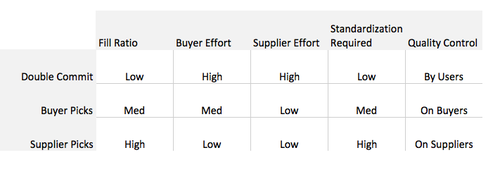What type of marketplace are you?
A founder proudly told me yesterday that “Liquidity is not a problem. 71 people applied to a job within 24 hours!”
I replied, “That sucks… 70 out of 71 of your users had a bad experience."
———–
This led me to think about the different types of possible workflows for marketplaces. I wanted to share my thoughts on a framework for thinking about the different types of marketplace matching mechanisms. It’s absolutely critical to think through the correct workflow for matching in a marketplace. There is no single right answer - it all depends on the service that you provide. My experience has also been that almost everyone starts with an overly complex workflow. The simpler and faster you can make the matching process, the faster you’ll be able to grow.
Double Commit Marketplace
Examples: Care.com, oDesk, Thumbtack.
A typical workflow: Buyer posts job. Buyer invites candidates AND Candidates apply to job. Interviews happen. Buyer makes a hire.
These marketplaces are the easiest in some sense because all of the curation, filtering, and matching is really done by the users. They also allow for completely custom needs to be fulfilled since people can chat and interview and be flexible. On the other hand, these marketplaces tend to have the lowest overall fill ratio (hires made / jobs posted) since there is substantial time and effort required by both sides. They are also the least efficient overall since much time and energy is "wasted” on applications and interviews that do not turn into real work. As a result, one of the big risks is that you end up with a vicious cycle of quality. If high quality suppliers get frustrated with the process, they will leave.
The key focus for the company in this case is often on improving the fill ratio. Lots of emphasis is often placed on streamlining the candidate -> interview -> hire process since there is significant dropoff through this funnel.
———
The next evolution of marketplaces is to single-commit models, where one side can make a transaction without the active approval of the other side. There are two types of single-commit models – you could have the buyer pick or the supplier pick. As soon as a marketplace moves to a “single commit” model, they must be responsible for the quality of at least one side of the marketplace.
Buyer-Picks Marketplace
Examples: YourMechanic, Unwind.me, Airbnb.
A typical workflow: Suppliers enter availability. Buyer can see available suppliers. Hires a supplier without discussion.
These marketplaces are a bit more complicated since additional availability criteria must be captured from the suppliers. It does not fit well with low utilization marketplaces. For example, if a mechanic was only getting 5% of his work through YourMechanic – he is unlikely to keep his schedule up to date and be responsive and available when anyone wanted to book an appointment. In addition, the suppliers in a buyer-picks marketplace can often get frustrated because they have no control over their own utilization rates. It’s important for a buyer-picks marketplace to keep a close eye on utilization rates.
I include Airbnb as a buyer-picks marketplace since they are increasingly trying to move to Instant Bookings for properties. These consist of a curated listing with professional photos and an up-to-date calendar of availability. It also requires that Airbnb becomes at least somewhat responsible for the quality of the buyers. If they send offensive, dirty, rude, etc buyers, then the suppliers will leave the platform or at least no longer allow instant, unapproved bookings.
The key emphasis here is typically on quantity and quality of listings and maintaining accurate availability of suppliers so that buyer demand is always filled.
Supplier-Picks Marketplace
Examples: Uber, Rev.
A typical workflow: Buyer posts job. Approved suppliers see available jobs. Supplier claims job.
These marketplaces require the highest degree of job standardization and quality control by the marketplace. Since a high degree of standardization is required, these ones must go after a specific vertical, such as usability testing. With respect to quality, in an open double-commit marketplace, poor quality results are not blamed on the company. However, in a supplier-picks version, all of the blame will be put on the company if there is a negative experience. On the plus side, these marketplaces can have by far the highest fill ratios since it is possible to drive towards 100% of jobs getting claimed by suppliers.
The key emphasis here is on maintaining an active and curated pool of suppliers so all jobs are done quickly and effectively.
The Pros and Cons

————-
I think whenever possible, you should try to be a supplier-picks marketplace. They have the highest potential growth rates and can have the best overall user experience (highly correlated with low effort and high quality). They are also the hardest though, they require constant attention to balancing supply and demand and running exceptional operations.
chaswagner liked this
 jbreinlinger posted this
jbreinlinger posted this